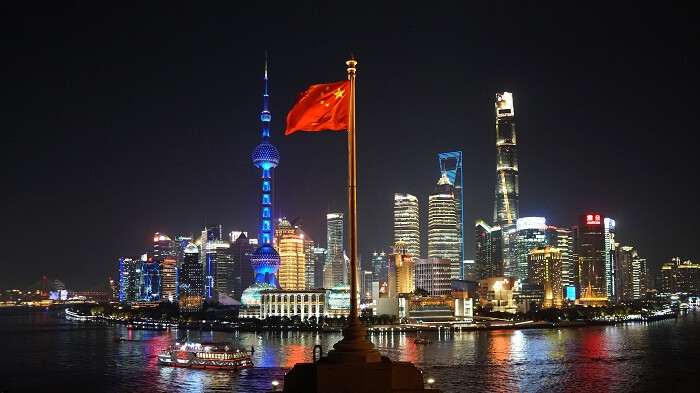
Beijing, China - Defying the headwinds of an escalating trade war with the United States, the Chinese economy has demonstrated surprising resilience in the first quarter of 2025, with key indicators pointing towards a recovery. Data released by various government agencies reveals a robust performance in trade, transportation, and industrial profits, underscoring the underlying strength of the world's second-largest economy.
According to the State Administration of Foreign Exchange, China's total trade in goods and services reached a substantial 4.27 trillion yuan (approximately $590 billion USD) last month, marking a solid 6% increase compared to the same period last year. This growth is particularly noteworthy given the intensified tariff pressures imposed by Washington.
The goods sector emerged as a significant contributor, with exports soaring to 2.13 trillion yuan ($294 billion USD) and imports reaching 1.52 trillion yuan ($210 billion USD), resulting in a healthy trade surplus of 603.4 billion yuan ($83 billion USD). While the service trade experienced a deficit of 139.8 billion yuan ($19 billion USD), the overall trade performance signals China's adeptness at navigating the complex global economic landscape by actively seeking new international markets and bolstering domestic consumption.
The vitality of the Chinese economy is further reflected in the burgeoning transportation sector. The Ministry of Transport reported significant year-on-year increases in passenger traffic across various modes. Railway passenger volume surged by 5.9% to 1.07 billion, while civil aviation saw a 4.9% rise to 190 million passengers. Road travel also experienced a notable 3.9% increase, with 1.607 billion passenger trips recorded.
The recent Chunyun period, the annual Spring Festival travel rush, witnessed an unprecedented 9.02 billion inter-regional passenger movements, the highest ever recorded. This remarkable figure underscores the complete resurgence of human mobility within China following the disruptions caused by the COVID-19 pandemic.
Furthermore, freight transport experienced a healthy expansion, with a 4.9% increase to 1.306 billion tons. Port activity also demonstrated robust growth, with cargo throughput rising by 3.2% to 4.22 billion tons and container throughput expanding by an impressive 8.2% to 83.03 million TEUs. These figures collectively paint a picture of a dynamic and recovering economic engine.
In a significant development, the National Bureau of Statistics announced that the total profits of large-scale industrial enterprises (those with an annual revenue exceeding 20 million yuan) reversed a previous downward trend, registering a 0.8% year-on-year increase in the first quarter, reaching 1.51 trillion yuan ($208 billion USD). This positive shift marks the end of a decline that had persisted since the third quarter of the previous year.
Wei Yueming from the National Bureau of Statistics highlighted that approximately 60% of the large industrial sector experienced profit growth, with 24 out of 41 major industrial categories reporting increased profits compared to the same period in 2024. Notably, the manufacturing sector demonstrated a strong recovery, achieving a 7.6% increase in profits.
Faced with the challenges posed by the intensifying trade friction with the United States, China is strategically focusing on the digitalization and smartization of its infrastructure as a key strategy for future growth. The ongoing renovation project of the Beijing East 6th Ring Road serves as a prime example, incorporating cutting-edge technologies such as digital twins and the Internet of Things (IoT). These advancements have already yielded significant results, reducing labor costs by 33% and boosting production efficiency by 30%.
Jin Jingdong of the Ministry of Transport emphasized the critical role of digital transformation in the transportation sector, stating that it is "an important means to realize a strong transportation nation, digital China, and promote the development of new quality productive forces." The government's commitment to this strategy is further evidenced by the selection of 12 regions this year to receive support for the digital transformation of their road and waterway transportation infrastructure.
The apparent resilience of the Chinese economy amidst the escalating US-China trade war suggests that Beijing's 'dual circulation' strategy, which prioritizes boosting domestic demand alongside international engagement and a strong emphasis on digital transformation, is beginning to yield tangible results. By focusing on its vast domestic market and embracing technological advancements, China appears to be mitigating some of the adverse effects of external pressures.
However, analysts caution that the long-term impact of the protracted US-China trade dispute remains a significant concern, particularly for China's export-oriented manufacturing sector. While the current data offers a glimmer of optimism, the sustainability of this recovery in the face of ongoing geopolitical and economic tensions will be closely watched by the global community. The coming months will be crucial in determining whether China's internal strengths and strategic initiatives can effectively buffer its economy against the external storm.
[Copyright (c) Global Economic Times. All Rights Reserved.]






























